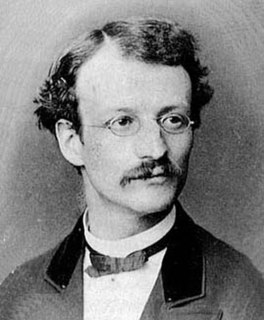Calculus is the mathematical study of continuous change, in the same way that geometry is the study of shape and algebra is the study of generalizations of arithmetic operations.

In mathematics, an integral assigns numbers to functions in a way that can describe displacement, area, volume, and other concepts that arise by combining infinitesimal data. Integration is one of the two main operations of calculus, with its inverse operation, differentiation, being the other. Given a function f of a real variable x and an interval [a, b] of the real line, the definite integral
The Analytical Society was a group of individuals in early-19th-century Britain whose aim was to promote the use of Leibnizian notation for differentiation in calculus as opposed to the Newton notation for differentiation. The latter system came into being in the 18th century as a convention of Sir Isaac Newton, and was in use throughout Great Britain. According to a mathematical historian:

Michael David Spivak is an American mathematician specializing in differential geometry, an expositor of mathematics, and the founder of Publish-or-Perish Press. Spivak is the author of the five-volume A Comprehensive Introduction to Differential Geometry. In 1964 Spivak received a Ph.D. from Princeton University under the supervision of John Milnor. In 1985 Spivak received the Leroy P. Steele Prize.
Robert Woodhouse was an English mathematician.
Robert Daniel Carmichael was an American mathematician.

Richard Courant was a German American mathematician. He is best known by the general public for the book What is Mathematics?, co-written with Herbert Robbins.
Donald Clayton Spencer was an American mathematician, known for work on deformation theory of structures arising in differential geometry, and on several complex variables from the point of view of partial differential equations. He was born in Boulder, Colorado, and educated at the University of Colorado and MIT.
Calculus, known in its early history as infinitesimal calculus, is a mathematical discipline focused on limits, functions, derivatives, integrals, and infinite series. Isaac Newton and Gottfried Wilhelm Leibniz independently discovered calculus in the mid-17th century. However, both inventors claimed that the other had stolen his work, and the Leibniz-Newton calculus controversy continued until the end of their lives.
Norman Levinson was an American mathematician. Some of his major contributions were in the study of Fourier transforms, complex analysis, non-linear differential equations, number theory, and signal processing. He worked closely with Norbert Wiener in his early career. He joined the faculty of the Massachusetts Institute of Technology in 1937. In 1954, he was awarded the Bôcher Memorial Prize of the American Mathematical Society and in 1971 the Chauvenet Prize of the Mathematical Association of America for his paper A Motivated Account of an Elementary Proof of the Prime Number Theorem. In 1974 he published a paper proving that more than a third of the zeros of the Riemann zeta function lie on the critical line, a result later improved to two fifths by Conrey.

William Fogg Osgood was an American mathematician, born in Boston.
Daniel Alexander Murray (1862–1934) was a Canadian mathematician.
Lipman "Lipa" Bers was an American mathematician born in Riga who created the theory of pseudoanalytic functions and worked on Riemann surfaces and Kleinian groups. He was also known for his work in human rights activism.

Oskar Bolza was a German mathematician, and student of Felix Klein. He was born in Bad Bergzabern, Palatinate, then a district of Bavaria, known for his research in the calculus of variations, particularly influenced by Karl Weierstrass' 1879 lectures on the subject.

William Holding Echols, generally called "Reddy" Echols, was a professor of mathematics at the University of Virginia. The Echols Scholars Program is named in his honor.
Professor Earl David Rainville taught in the Department of Engineering Mathematics at the University of Michigan, where he began as an assistant professor in 1941. He studied at the University of Colorado, receiving his B.A. there in 1930 before going on to graduate studies at Michigan, where he received his Ph.D. in 1939 under the supervision of Ruel Churchill. He died on April 29, 1966.
Earle Raymond Hedrick, was an American mathematician and a vice-president of the University of California.
In mathematics, a multiplicative calculus is a system with two multiplicative operators, called a "multiplicative derivative" and a "multiplicative integral", which are inversely related in a manner analogous to the inverse relationship between the derivative and integral in the classical calculus of Newton and Leibniz. The multiplicative calculi provide alternatives to the classical calculus, which has an additive derivative and an additive integral.
James McMahon was an Irish mathematician whose career was spent at Cornell University in Ithaca, New York. He was a committed educator, and an early proponent of professionalization in the teaching of advanced mathematics in America. A professor and Chairman of the Mathematics Department in Cornell University’s College of Arts & Sciences, McMahon was one of the earliest members of the American Mathematical Society in 1891. For seven years he served as associate editor of the Annals of Mathematics. He was also the American Association for the Advancement of Science’s Secretary (1897), Section A ; General Secretary (1898), and Vice-President (1901). McMahon was also featured in the publication, American Men of Science.

Georg Scheffers was a German mathematician specializing in differential geometry. He was born on November 21, 1866 in the village of Altendorf near Holzminden. Scheffers began his university career at the University of Leipzig where he studied with Felix Klein and Sophus Lie. Scheffers was a coauthor with Lie for three of the earliest expressions of Lie theory:










